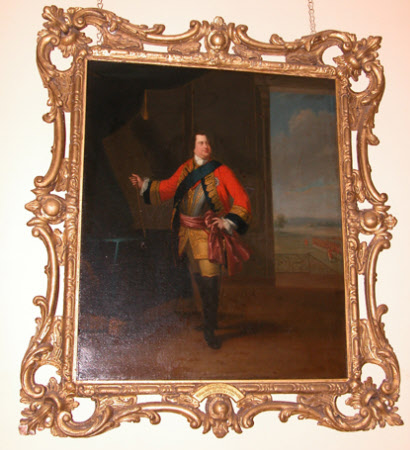Prince William Augustus, Duke of Cumberland (1721–1765)
studio of David Morier (Berne 1705 – London 1770)
Category
Art / Oil paintings
Date
circa 1760
Materials
Oil on canvas
Measurements
740 x 620 mm
Order this imageCollection
Anglesey Abbey, Cambridgeshire
NT 515501
Summary
Oil painting on canvas, Prince William Augustus, Duke of Cumberland (1721–1765), studio of David Morier (Berne 1705 – London 1770). A full-length portrait, standing in an interior, facing right, left hand on hip, his right hand supports a baton held upright on a green velvet covered table with gilt braid edging; wearing red military state uniform with Star of the Garter and Order of the Bath; the uniform consists of a red coat with black and gold facings, white shirt and white frill cuffs, a silvery cuirass with gilt decorations worn over a cream thigh-long waistcoat, decorated with gilt braid, buckskin breeches and a large plum-red sash tied with a large bow at the left hip; dark thigh-high boots; an interior on the left with drape and single gold tassel hanging from the ceiling, an open door onto terrace at the right, through which can be seen a parade ground on which is drawn up a detachment of Foot Guards. Label on frame 'Field Marshal William Augustus, Duke of Cumberland, 1705. D. Morier 1770'. The original is in the Royal Collection, this version is probably a studio copy. The sitter was the third surviving son of George II (1683-1760) and (Wilhelmina Charlotte) Caroline of Brandenburg-Ansbach (1683-1737). He was born at Leicester House, St Martin’s-in-the-Fields, London. He was made a Knight of the Bath in 1725 and created Duke of Cumberland, Marquess of Berkhamstead, Earl of Kennington, Viscount Trematon, and Baron of Alderney in 1726 and Knight of the Garter in 1730. He served with distinction at Dettingen in 1743. He was defeated Prince Charles, ‘The Young Pretender’, at Culloden in 1746; for severity against Jacobites he earned the nickname of ‘Butcher of Culloden’. Horace Walpole described him as ‘proud and unforgiving, fond of war for its own sake’ In command in Holland. Defeated at Laeffelt in 1747 and by French in Germany in 1757, when he resigned command. Owned one of best studs in England. Died unmarried at his house in Upper Grosvenor Street, London, and was buried in Westminster Abbey. The type of portrait appears to represent Cumberland during his command in Low Countries, 1747/49 and the original may have been painted when Morier was in Germany, 1748/49. The Duke of Cumberland patronised the Swiss artist David Morier, who was in the Duke’s service by 1748. In return Morier painted a series of pictures of soldiers in the uniforms of the British and allied armies (1751-60) as well as the Duke’s portrait. The original portrait is in the Royal Collection, while the National Portrait Gallery owns a version which shows minor differences. The Anglesey Abbey version is assumed to be a studio copy. Cumberland wears a Garter and the Order of the Bath. David Morier was a Swiss painter of military subjects. Born in Berne, Switzerland, around 1705, he came to London around 1743. Presented by Sir Edward Faulkner to William Augustus, Duke of Cumberland, (1721 1765), he was in the Duke’s service by 1748 receiving an annuity of £200, in return painting immense series of pictures of soldiers in uniforms of British and allied armies between 1751-60. George I and George II sat to him. Evidence in contemporary accounts show that Morier was in the Low Countries in 1748-9. Distinguished himself as painter of battles, dogs, horses and portraits. Painted horses in equestrian portraits of Richard Brompton. In 1760, Morier showed equestrian portraits at first exhibition of Society of Artists, where he also exhibited on three subsequent occasions; became a Member. Also exhibited at Society of Arts between 1760-68. In 1769, having fallen upon hard times, Morier was confined in the Fleet Prison, where he died in 1770. Buried at the expense of the Society of Artists, in St. James’ Church, Clerkenwell.
Provenance
Bequeathed to the National Trust by Huttleston Rogers Broughton, 1st Lord Fairhaven (1896-1966) with the house and the rest of the contents.
Credit line
Anglesey Abbey, The Fairhaven Collection (National Trust)
Makers and roles
studio of David Morier (Berne 1705 – London 1770), artist


